A Multi-Genre Project
Catherine Gregory
June 2020
Contents
- Introduction
- TimeLine
- How to Spot a Dictator: Venn Diagram
- Mussolini Quotes
- Women and Italian Fascism
- Giovinezza Hymn
- Galleries – Art and Architecture, Propaganda, Mussolini
- References
Introduction – Dedication
One hundred years ago the people of the nation of Italy were divided. The landowners and church defended their aristocracy, the politically inefficient and the status quo. On the other side of the chasm were the workers and the proletariat, inspired since 1776 up to the recent possibilities in revolutionary Russia, they were calling for revolutionary change.
Benito Mussolini was a strongman, a dictator. A man with a vision for Italy who conformed to and shaped these troublesome times. But just how did a liberal constitutional monarchy change so quickly into a fascist totalitarian state? And who was left behind in this so called revolution? The life and times of Mussolini, dictator, can tell us much about the state of a nation and its leader at the turn of the twentieth century and from here we can see the reflections into the minds and hearts of fascists everywhere.
This work is dedicated to all the women silenced by all the men, the men who thought they knew better, who thought freedom was a one gender street and who, for millennia, disposed of women in diverse ways.
Catherine Gregory
ps: On April 6, 2020 I was to fly into Rome, Italy. It was to be my first ever Italian adventure, including a whole month in Florence, a week in Rome and two weeks catching some Giro d’Italia stages in northern Italy. It was a trip of a lifetime. Then Covid-19. They say Rome will be there next year, I can only hope that so will I.
Benito Mussolini, Dictator
TimeLine
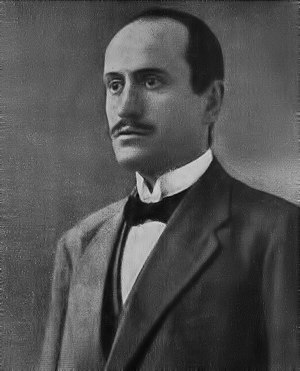
1883 July 29 – Birth of Benito Mussolini to parents Rosa Maltoni, Teacher and Alessandro Mussolini, Blacksmith. His birth was near Predappio Nuova, in the Emilia-Romagna region of northern Italy. His father was a socialist and revolutionary. His mother was the local primary school teacher and a devout Catholic. He had two younger siblings. At the age of 9 he was sent to boarding school in Faenza where he was expelled for pulling a knife on another student. 1 (Clark, p8)
1899 (age 16) – Mussolini loses his virginity in a Forli brothel. 2 (ibid, p10)
1901 (18) – Chosen to give the commemorative address on the death of Giuseppe Verdi and qualified as a primary school teacher. (ibid, p10)
1902 (19)– Without a job he met and seduced Virginia E. and Giulia, the wife of a soldier. (ibid, p11)
1903 (20) – Mussolini began writing. He was a journalist for L’avvenire del Lavoratore in Lausaane and an agitator for the Italian immigrant worker community. He became known in Socialist circles and Angelica Balabanova became his mistress and mentor. (ibid, p11)
1904 (21) – Attended University of Lausanne summer course and read Nietzsche, Carlyle, Stirner, Blanqui. The books that would confirm his biases. (ibid, p 12 )
1905-6 (22-23) – Military Service – 10th regiment of Bersaglieri in Verona. (ibid, p 12 )
1908 (25) – Publication of George Sorel’s “Reflections on Violence” which influenced Mussolini as well as a others who would later became fascists. (Lindemann, p168)
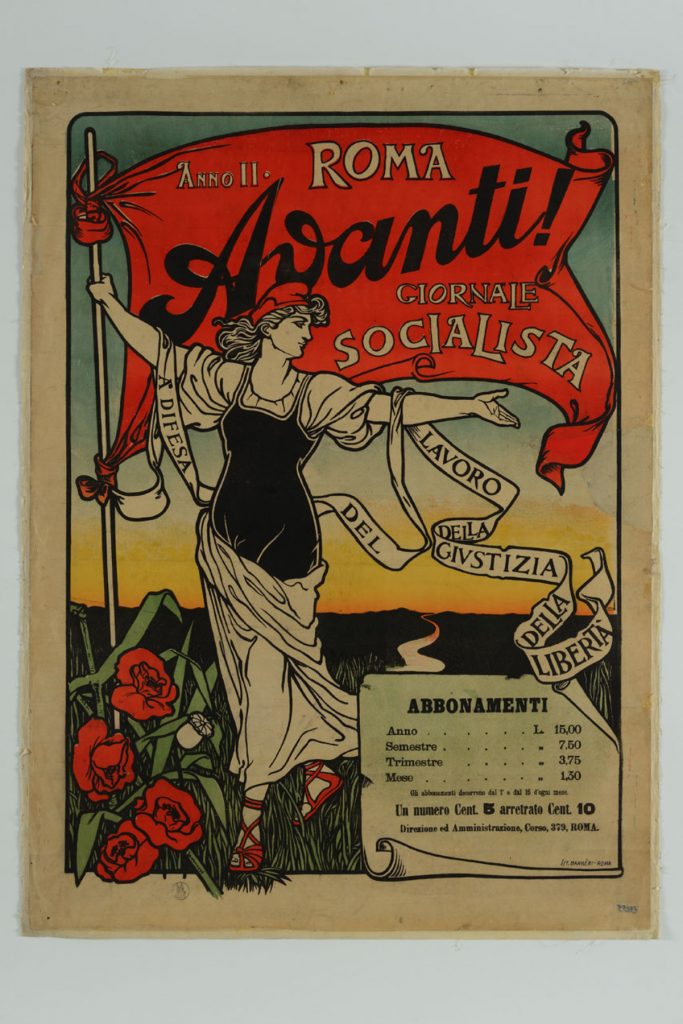
1909 (26) – After being expelled from Austria and cantons in Switzerland, and after the death of his mother, Mussolini ended up in Forlì, where he was head of the local Socialist Party. Here he began a serious writing career. (Clark, p15)
1910(27) – Begins a domestic relationship with Rachele Guidi. He marries her in 1915, two months before the death of his father. (ibid, p14)
1911(28) – Imprisoned for his part in demonstrations against the Libyan War. Writes ‘La Mia Vita.'(ibid, p16)
1912 (29) – Move from Forli to Milan as successful, yet tethered to the party elite, editor of Avanti!, a leading Socialist Journal. He also gave speeches supporting socialism. (ibid, p19)
1913 (30) – Mussolini’s Utopia, a bi-weekly journal proclaiming Mussolini’s socialist beliefs, published the works of other like-minded writers. (ibid, p19)
1914 – 1918 (31-35) WW1 -Europe’s patriotic fever – “nationalism will save humanity.” (Lindeman, p183) Mussolini broke with the neutralist Socialist party and became a spokesperson for intervention and for war as a way to revolution in Italy. His lover at this time was the wealthy Margherita Sarfatti. In 1915 he spent seventeen months in the 33rd Battalion, 10th Bersaglieri Regiment.
1919-1920 (36-37) – Bolshevism unites the divisions on both sides of the political spectrum. In Italy, landowners and the church see a violent revolutionary change as a threat to the status quo. Mussolini invents the Fascist Party as a new ideology. His critics would call him “venditore di fumo” (smoke/snakeoil salesman) and the post WW1 populations were buying smoke.
1921 (38) – With post-Versailles international frustrations and economic woefulness at home, communists against anarchists against fascists caused riots in the cities. Mussolini, the strong man, and his friends create the problem only Mussolini, and his friends could solve. He wins a seat in the Parliamentary elections.
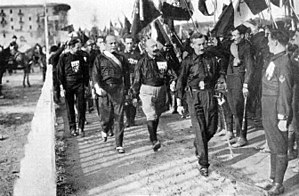
1922 (39) – The March on Rome was an organized mass demonstration resulting in Mussolini becoming Prime Minister of Italy. Fearing a civil war, he was appointed by King Victor Emmanuel III at a time when Italy’s main political parties, the Catholic Populist Party (the Popolari) and the Italian Socialist Party (PSI) would not work together, resulting in an ineffectual government and chaos in the streets. At the time, Mussolini’s Fascist Party had only 35 out of 535 deputies in parliament. (Lindemann, p253)
1923 (40) – The Corfu Incident. After the assassination and murder of Italian nationals, including General Tellini, Mussolini orders the bombardment and occupation of Corfu. This rash action, which killed refugees including children, is scorned by Italian elites and the international community. “The crime of Corfu was official murder by a civilized nation…I consider the manner in which Corfu was occupied as inhuman.” – Dr. William Kennedy, Chairman, League of Nations
1924 (41) – General Elections in Italy. Mussolini wins. These would be the last multi-party elections in Italy until 1945.
1925 (42) – Mussolini insisted on his innocence in the death of opposition leader Giacomo Matteotti and his January 3rd speech, in which he asserts his right to supreme power through violence and power, puts an end to the pretense of democracy in Italy. By December 24 he had changed his title from from President of the Council of Ministers to Head of the Government, only responsible to the King. (Iodice, p 7, 10) Also, this was the year that women’s suffrage, in local elections, was first granted. Except for in Tuscany when women’s suffrage was granted in 1848.
1926 (43) – Mussolini worked to consolidate his dictatorial power by setting up a secret police and a fascist youth program. Other political parties are banned. The death penalty was returned to Italy. (Iodice, p11)Novelist Grazia Deledda is the first Italian woman to win a Nobel Prize.
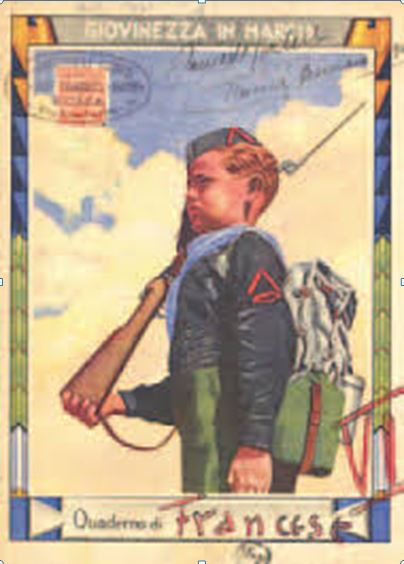
1927 (44) – TheCharter of Labour (Carta del Lavoro) was legislation introduced by Mussolini as an attempt to modernize the Italian economy. The charter declared private enterprise to be the most efficient thereby confirming the support of the rich industrialists . (Clark, p128)
1928 (45) – A bomb, intended for Mussolini, kills 18 people at the Milan Trade Fair. (Wiki 1928)
1929 (46) – Signing of the Lateran Concordat with the Papacy formalizing the relations between the Holy See and the Kingdom of Italy. (Lindemann, p257)
1930 (47) – Trying to combat economic depression Mussolini encouraged Italians to donate all their gold to the state in a “Gold for the Fatherland” initiative. (Wikipedia, https://en.wikipedia.org/wiki/Propaganda_of_Fascist_Italy)
1931 (48) -Mussolini became a grandfather. Arnaldo, his trusted brother, died. (Clark, p 145)
1932 (49) – Mussolini reshuffles his cabinet and personally takes on the tasks of Foreign Affairs and Corporations. Decennial of the March on Rome celebrated with the opening of Via dell’Impero and the Foro Mussolini. He promises to remain dictator for 30 years. (Wikipedia Italy in 1932)
1933 (50) – In January – Mussolini proposes a Four-Power Pact of Italy, Germany, Britain and France. Only Germany is interested. In September Mussolini signs a non-aggression pact with the USSR. This is also the time he meets Carletta Petacci. (Clark p209)
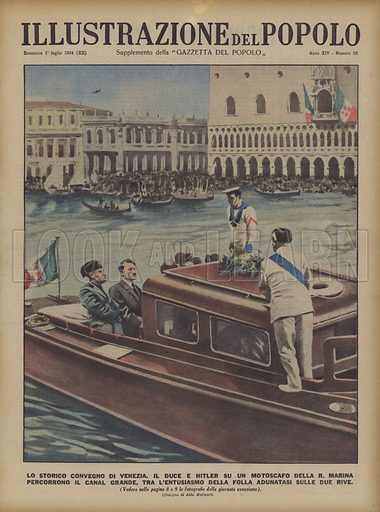
1934 (51) – Jun 14 – Mussolini and Hitler meet for the first time in Venice. The Italian national football team wins its first FIFA World Cup.
1935 (52) – Oct 3 – troops stationed in Eritrea cross the river and occupy Ethiopia (Abyssinia) , violating Article XVI of the League of Nations statute. Many civilians die. The League of Nations hits the Kingdom of Italy with economic sanctions.
1936 (53) – May 9 – Addis Ababa was formally occupied, the Emperor Haile Selassie went into exile. This action isolated Italy in the international community. (Italian Ethiopia – Wikipedia) Hitler and Mussolini sign the Rome-Berlin Axis. Mussolini aligns with Spain.
1937 (54) – Mussolini takes Italy out of the League of Nations. Anti comintera pact with Germany and Japan which leads to the Axis Pact.
1938 (55) – Mussolini invades Albania. Formal military alliance with Nazis. Pact of Steel.
1939 (56) – Italy occupies Albania.
1940 (57) – Declares war on Britain and France.
1941 (58) – Mussolini is rebuked by Hitler for allowing the British to take Tripoli in Libya.
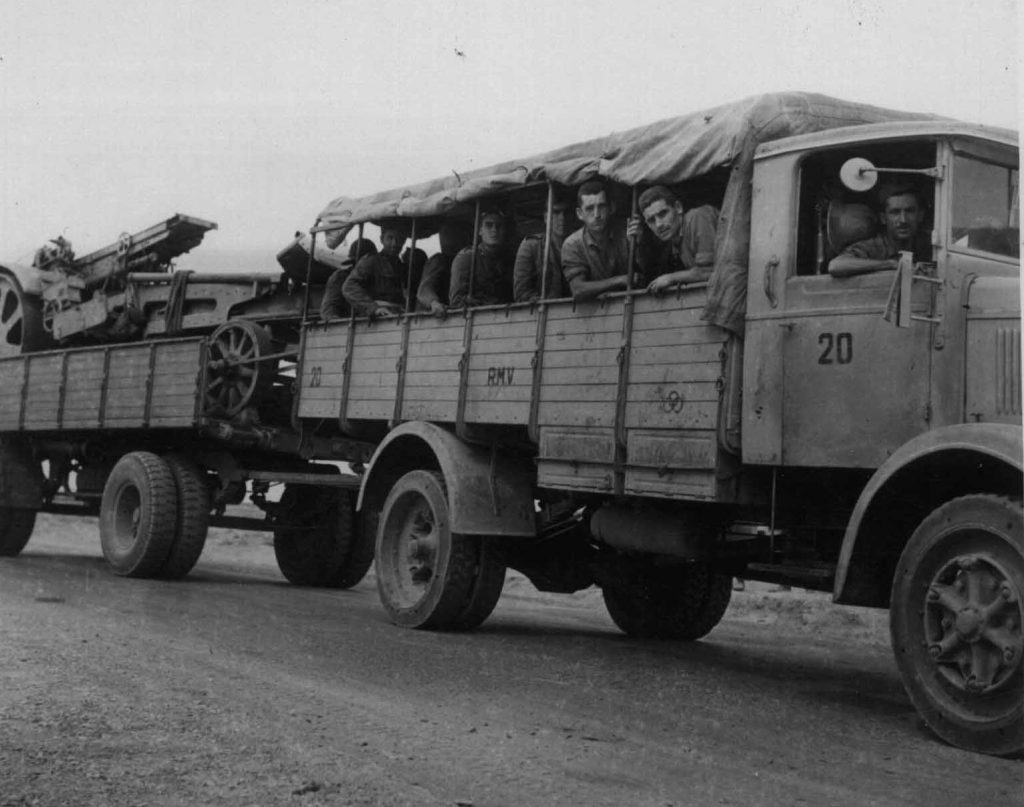
1942 (59) – The fall of Tobruk sees Mussolini congratulating Hitler on the success of German and Italian forces… “to march towards final victory shoulder to shoulder with your armed forces”…”our troops, welded together in many battles, will finally destroy the beaten enemy with all the power of a ruthless pursuit” (Imperial War Museums, Telegram June 22, 1942)
1943 (60) – On July 25th there was a vote of no confidence against Mussolini, an outcome led by King Victor Emmanuel III and Count Dino Grandi, looking to make peace with the Allies, and as Italians, particularly the Cosa Nostra, were now regarding the Nazis as their enemies. Mussolini, and his high ranking associates, had become enemies of the Italian Kingdom. He was arrested and moved from one location to another. However, Mussolini was freed by a German commando unit, with orders from Hitler, on September 12th, and set up in his own new fascist state called the Italian Social Republic in northern Italy.
1944 (61)– Rome falls to the Allies.
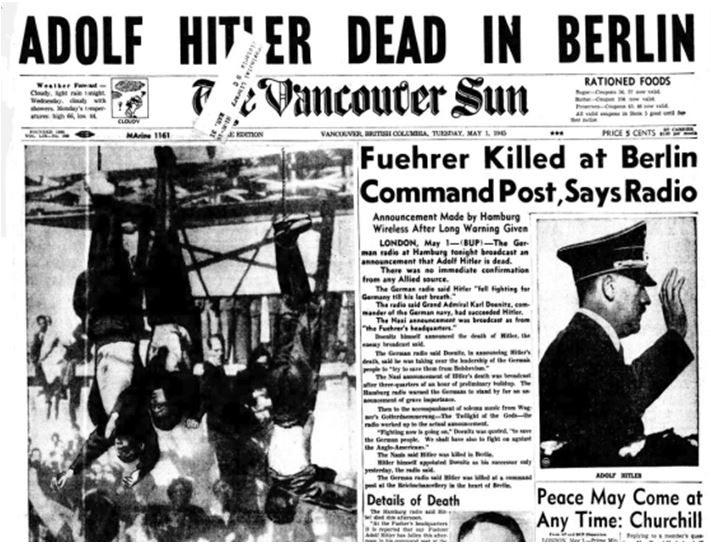
1945 (62) – April 28 – Death while fleeing Italy for Switzerland with his mistress, Carletta Petaccii, Mussolini and Petaccii were arrested by Partisans then executed. This was only two days before Hitler’s suicide. Mussolini’s body, along with Carletta’s, were taken to Milan and hung upside down in the Piazza Loreta, where citizens abused the dead bodies with hammers and guns. It would be twelve years later that his body was interred in his family’s crypt in Predappio.
1946 – July 2 – Italy’s monarchy is abolished. It is replaced with a liberal democratic republic.
Mussolini Speech
March 26, 1939 with English subtitles. Translated by the New York Times.
How to Spot a Dictator
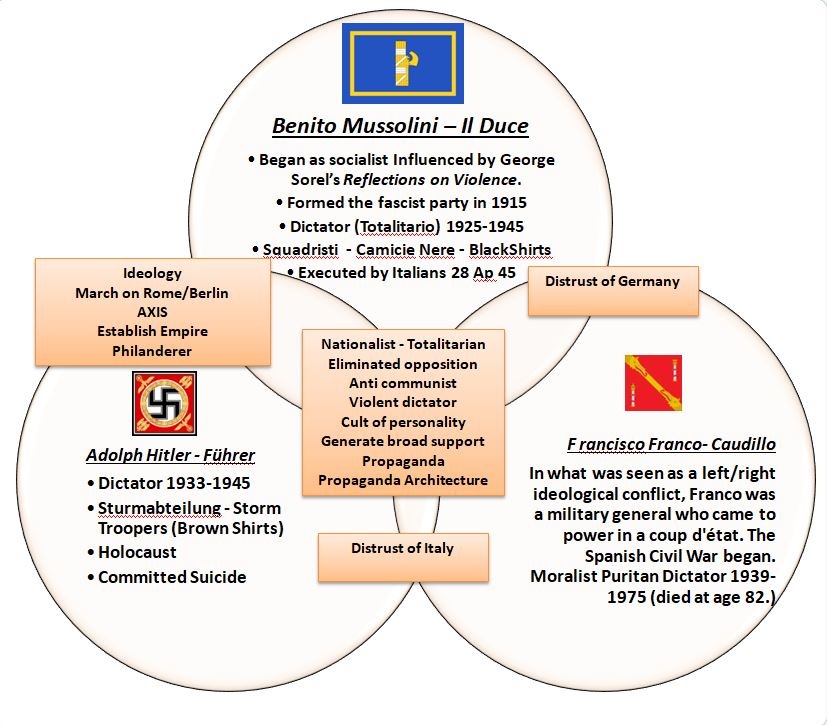
Mussolini Quotes
‘Our formula is this: everything within the state, nothing outside the state, no one against the state’
(Mussolini in Milan; cited in Roberts 2006: p272)
‘War is the normal state of the people.’
“Duce (1922-42)” in TIME magazine (August 2, 1943)
‘Better to live a day as a lion than 100 years as a sheep.’
Attributed in “Duce (1922-42)” in TIME magazine (2 August 1943)
‘Female fascism who bravely wears the glorious black shirt and gathers around our pennants, is destined to write a splendid story, to leave memorable traces, to make an ever deeper contribution of passions and works to Italian fascism.’
(from Scritti e discourse , vol. III, p. 109)
‘In every anarchist there is a failed dictator.’
(Quoted in Emil Ludwig , Conversations with Mussolini , translation by Tomaso Gnoli, Mondadori, 2000.)
‘At the table we boys sat in three departments. I always had to sit at the bottom and eat with the poorest. I could perhaps forget the ants in the third class bread. But that we children were divided into classes, it still burns in my soul! ‘
(Quoted in Emil Ludwig , Conversations with Mussolini , translation by Tomaso Gnoli, Mondadori, 2000.)
‘We continue to march in peace for the tasks that await us tomorrow and that we will face with our courage, with our faith, with our will. Long live Italy!’
(from the speech given on May 5, 1936)
‘Let the glories of the past be surpassed by the glories of the future.’
(from Scritti e discourse , vol VII, p. 256)
‘To govern the Italians is not difficult, it is useless.’
Colloqui con Mussolini , Mondadori, 1932
‘Who is not with us is against us.’
(Teatro Costanzi, Rome, March 24, 1924; from Scritti e speeches , vol. IV, p. 81)
‘Giving up the fight means giving up on life.’
(Palazzo Chigi, 20 December 1923; from Scritti e discourse , vol. III, p. 290)
‘In all cases it is more likely that the United States, before it is attacked by Axis soldiers, will be attacked by the not well known but very warlike inhabitants of the planet Mars, who will descend from the stratosphere in unimaginable flying fortresses.’
Speech in Rome, Italy, February 23, 1941 printed in New York Times, February 24, 1941.
‘Europe will be dominated by Germany. The states won will be real colonies. Associated states will be confederate provinces. Among these, the most important is Italy. We must accept this state of affairs because any attempt to react would make us downgrade from the condition of a confederate province to that much worse than a colony.’
(from History – ideas, facts, protagonists , Vol. 3a, SIX)
‘Aim for the heart! ‘
Quoted in Aldo Lampredi, unpublished document on the end of the Duce , “L ‘Unità”, 1972.
Women of Italian Fascism
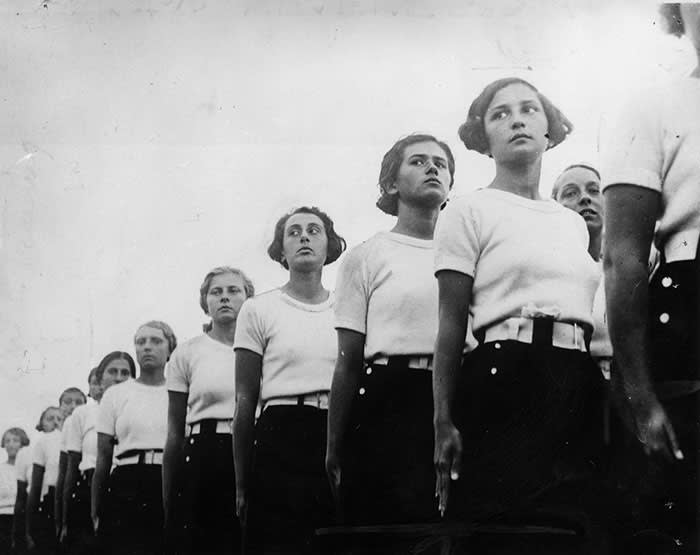
Italian woman were objects of desire, like a goddess as Era or like a diva as Madga Olivero, and as a bride and mother, a Madonna, as procreator of little fascist children who could be indoctrinated into fascism in nursery school. Women were, if not goddesses, then objects, to serve men with more warriors and more pasta. Mussolini, a notorious “womanizer,” understood the power of women in culture. He had seen what was happening in Russia, where for the first time ever, women were becoming political beings and interacting, if not on the world stage, then in national politics. Women’s suffrage and rights were key points in international socialism.
“It can therefore be considered a “merit” of fascism to have built, in its own way, a solid relationship between woman and politics, woman and nation, woman and homeland, and to have elaborated for her a political project that would redefine her private and public spaces, in order to create a political conscience that would give its consent to the establishment of the regime. ”
– Mussolini
Giovinezza Hymn
Giovinezza is Italian for youth. After many iterations in place and time, it became the official hymn of the Italian fascist party. This is the 1924 version which includes mention of Benito Mussolini. The hymn/anthem was sung at football games, rallies, films, and other public events. Even foreigners were given a good beating by the Camicie Nere (blackshirts) if they did not remove their hats when the song began.
To listen to the music
https://archive.org/details/78_fascisti-hymn-giovinezza_italian-military-band-g-blanc_gbia0120201b/Fascisti+Hymn+(Giovinezza)!+-+Italian+Military+Band.flac
Lyrics – https://en.wikipedia.org/wiki/Giovinezza#Lyrics
| Italian lyrics | English translation |
| Salve o popolo d’eroi Salve o patria immortale Son rinati i figli tuoi Con la fede e l’ideale Il valor dei tuoi guerrieri, La virtù dei tuoi pionieri La vision dell’Alighieri Oggi brilla in tutti i cuor Giovinezza, giovinezza, Primavera di bellezza Della vita, nell’asprezza Il tuo canto squilla e va! E per Benito Mussolini, Eja eja alalà! E per la nostra Patria bella, Eja eja alalà! Dell’Italia nei confini Son rifatti gli italiani; Li ha rifatti Mussolini Per la guerra di domani Per la gloria del lavoro Per la pace e per l’alloro, Per la gogna di coloro Che la patria rinnegar. I poeti e gli artigiani I signori e i contadini Con orgoglio d’italiani Giuran fede a Mussolini. Non v’è povero quartiere Che non mandi le sue schiere Che non spieghi le bandiere Del fascismo redentor | Hail, people of heroes, Hail, immortal Fatherland, Your sons were born again With the faith and the Ideal. Your warriors’ valour, Your pioneers’ virtue, Alighieri’s vision, Today shines in every heart Youth, Youth, Spring of beauty, In the hardship of life Your song rings and goes! And for Benito Mussolini, Hip, hip hooray! And for our beautiful Fatherland, Hip, hip hooray! In the Italian borders, Italians have been remade Mussolini has remade them For tomorrow’s war, For labour’s glory, For peace and for the laurel, For the shame of those Who repudiated our Fatherland The poets and the artisans, The lords and the countrymen, With an Italian’s pride Swear fealty to Mussolini No poor neighbourhood exists That doesn’t send its hordes That doesn’t unfurl the flags Of redeeming Fascism |
Next Page – Galleries
